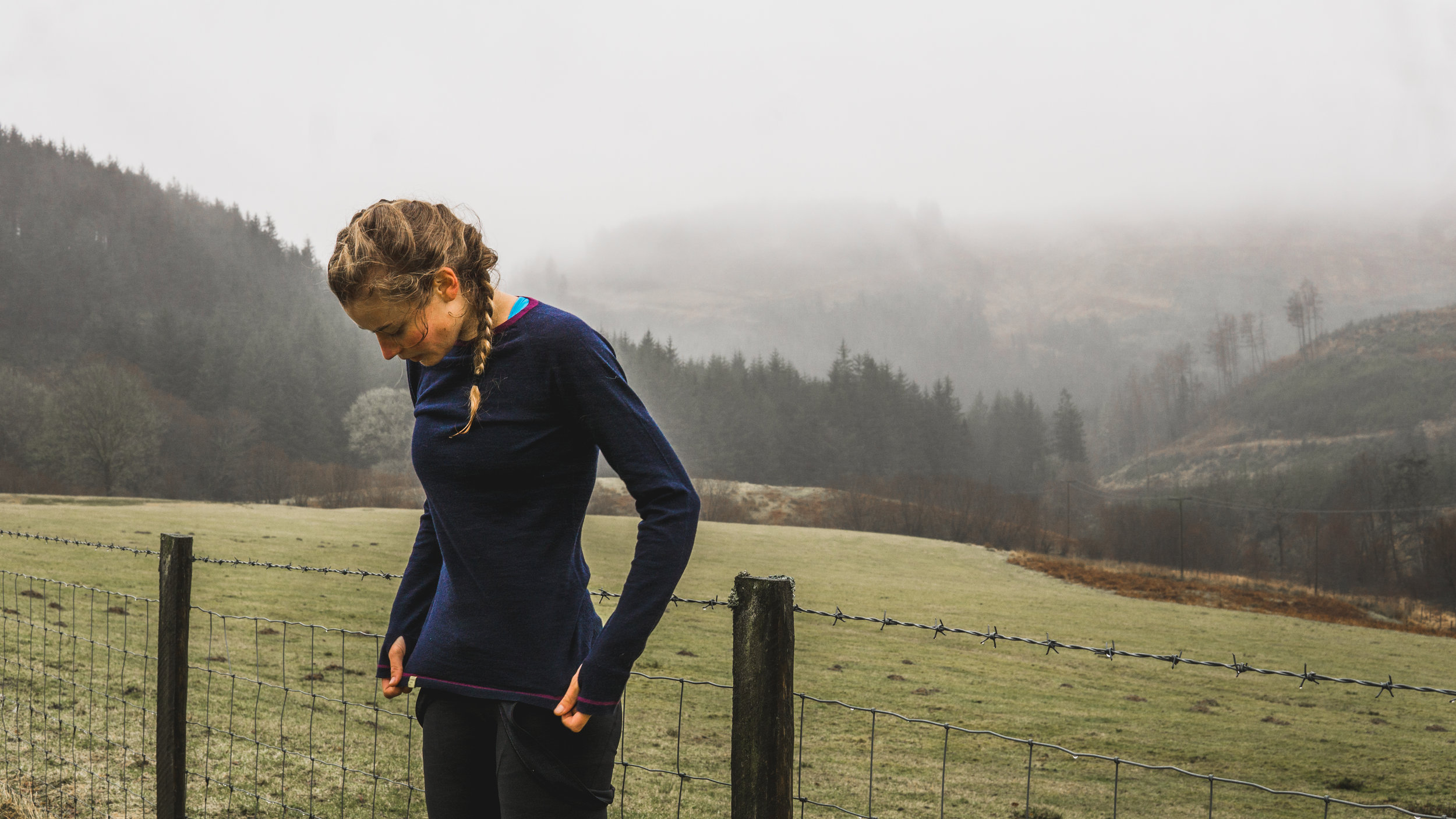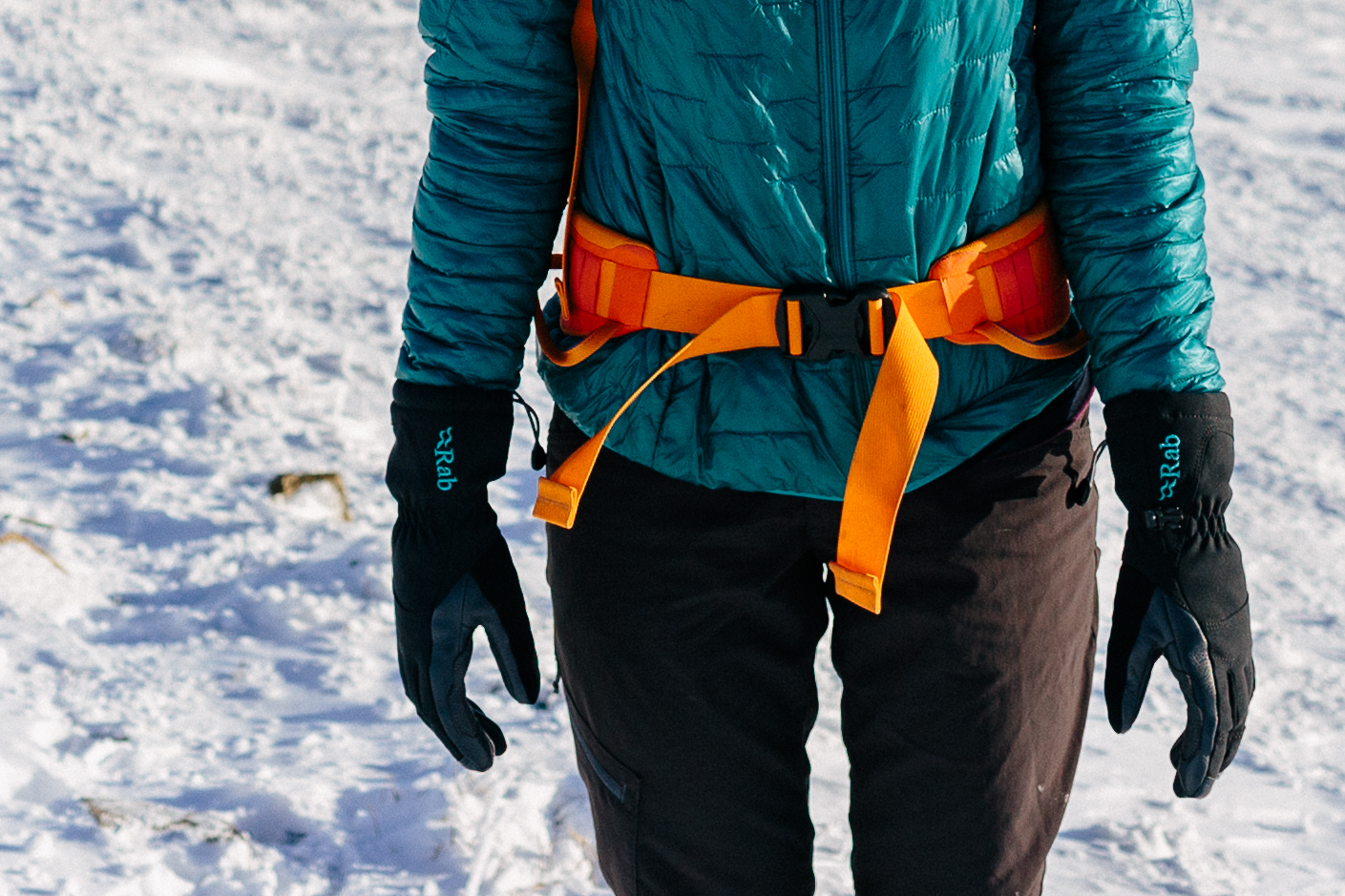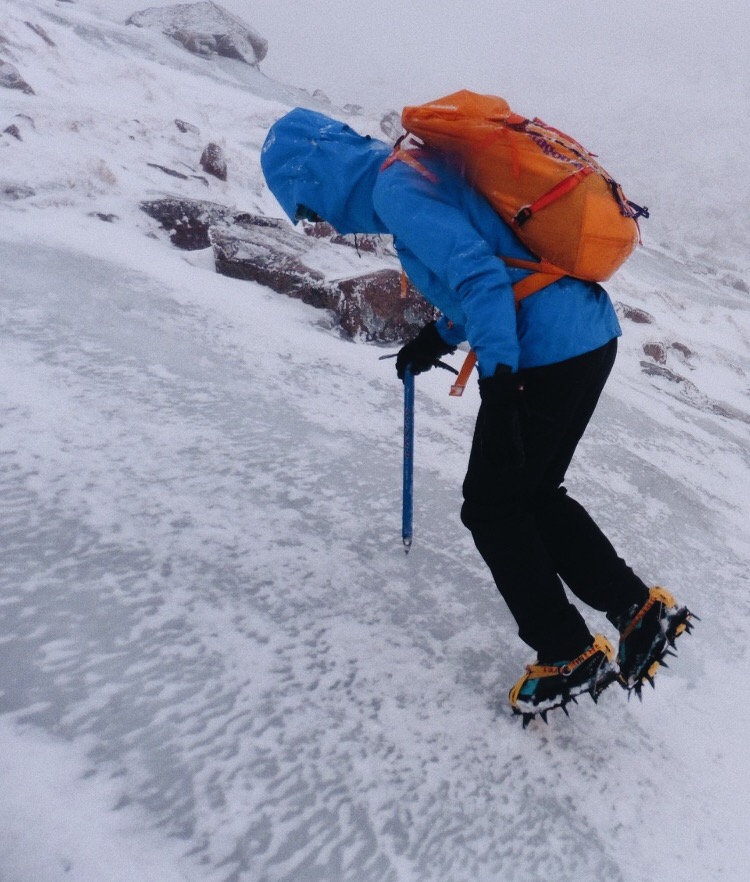Winter Mountaineering Gear
Gear can be a controversial topic. While some would argue that all you need is two feet and a heart that yearns for the hills to get out hiking, others relay the well-known mantra that “there’s no such thing as bad weather, only unsuitable clothing” that the one and only Alfred Wainwright pronounced. And who better than a man who has walked the length and breadth of the wet and wild Lake District to make such a claim?
Me? I’m caught somewhere in the middle. While I agree that going outside doesn’t have to require the most current and expensive clothing, I do maintain that if you want to pursue more ‘adventurous’ challenges in the hills and mountains, having appropriate clothing makes it a whole lot more comfortable, pleasant, and safer for you and those you’re travelling with. I’ve learned that lesson first-hand.
Why all the gear?
When I first started getting into hiking, I mostly wore a pair of Levi’s jeans and a vintage woolly jumper. Over time, I discovered that a good pair of walking trousers was essential, as was a wicking baselayer, and a solid waterproof jacket, and comfortable hiking boots, and so the list goes on… It was a gradual process, but through the help of working in an outdoor store, trolling Outdoor Gear Exchange on Facebook, and being gifted certain items because of my blog, I gradually built up a collection of good quality outdoor-wear that makes me feel protected and comfortable in the hills - gear that I know will keep me dry, warm, and safe in any scenario. It’s an investment in outdoor pursuits that I won’t regret.
When heading on a gentle ramble up a hill, I might still choose to wear my Levi’s and a cotton t-shirt now and again… But when tackling a winter summit that could take 6-8 hours, I carefully select what clothing I will wear and what I will carry in my pack. Before heading to the Cairngorms to go winter walking in January, I ensured I had everything I would need for tackling what could be difficult conditions.
I get asked a lot about gear, so I suppose some of you must be interested! I’ll admit I’ve become a little bit of a nerd when it comes to outdoor clothing and gear so I wanted to pass on some of what I have learned about hiking gear over the last couple of years. Starting with winter, arguably the time of year that it is most important to have the right kit. Here’s what I wore and carried in the Cairngorms…
Waterproof Trousers and Coat
Having good waterproofs is essential when you could be walking in snow or rain for hours on end. Gore-Tex is a good benchmark for waterproofing, however some brands also have their own waterproofing standard, such as Patagonia’s H2No. For winter hillwalking/mountaineering, you want waterproofs that will keep you fully protected against the elements whilst also being breathable. It’s worth investing a little more money for these elements. It’s also now possible to get recycled Gore-Tex, and waterproofing standards in the UK have changed so the top layer of DWR (Durable Water Repellency) is now a little kinder to the planet.
Trousers — In terms of waterproof trousers, you can either opt for a mountaineering trouser that fits on top of a baselayer, or a waterproof over-trouser that you wear over your normal walking trousers. For winter conditions, I would opt for a mountaineering trouser as I find them comfier and more breathable, and you will end up wearing them all day. A few mountaineering trousers I would recommend are:
Patagonia Galvanized Pants - £240
Mountain Equipment Manaslu Pants - £350
Rab Ascendor Pants - £160
Wearing the Patagonia Galvanized Pants
Coat — In winter, I opt for a larger jacket that will fit over a lot of layers. It’s more than likely that you’ll be wearing it all day so it doesn’t need to be packable. Features I like are chest pockets as well as normal pockets, and an adjustable hood as I might be wearing the coat with and without a helmet. A few winter waterproof coast I would recommend are:
Patagonia Triolet Jacket - £325
Montane Alpine Pro - £250
Insulation
The layer that keeps you warm is pretty important, as you’ll find yourself needing it a lot more in the winter months. There are two types of insulation you can go for; down or synthetic. As a general rule, down is warmer (provided it’s good quality down - 600 fill or above) but synthetic performs better when wet and is often lighter and more packable. When I know I’ll be wearing the jacket for being active, I’d personally rather opt for a synthetic jacket as the lighter weight makes it less bulky to wear, and I don’t have to worry if it gets wet (while down is damaged when wet).
It’s worth noting that whether or not you will actually wear your insulation when moving in the mountains depends on how cold the air is, and how cold a person you are. I know people who won’t ever wear their insulation when hiking in the mountains, only carrying it in their bag for the summit or descent. I am a cold person so I often hike in my insulation, even in the UK. Here are a few synthetic insulated jackets I would recommend for tackling winter mountains:
Patagonia Micro Puff (synthetic) - £250
Rab Microlight Summit (down) - £230
Black Diamond First Light Hoody (synthetic) - £200
Midlayers
Your midlayer is that extra bit of warmth between your insulation and baselayer. Sometimes, it stays tucked inside all your layers, but other times, when you’re exerting a lot of energy, you may be wearing it as your top layer. For this reason, a midlayer has to be very versatile and suitable for the needs of whatever pursuit you are heading out on.
The most traditional style of midlayer is the trusty old fleece, but these days brands have expanded into all kinds of midlayers made from synthetic fabrics. For me, a midlayer in winter should be highly breathable and lightweight. I might also end up wearing it as my top layer so I like it to sometimes be a little bit water resistant and windproof - though this can often retract from its breathability. The midlayer you go for really depends on you as a person, but here are a few midlayers I would recommend:
Patagonia Nano Air Light Hoody - £144
Patagonia R1/R2 (regulating fleeces, the R2 is warmer) - R1 £120; R2 £150
Rab Alpha Flux Jacket - £140
Wearing the Patagonia R2 in Nepal where temperatures dropped to -30 degrees celsius - i wore the fleece everyday
Patagonia Capilene Air Hoody
Findra Merino Baselayer
Baselayers
Baselayers are arguably the most important layer to ensure you stay warm and dry from sweat. In winter, a good baselayer is even more important because if you get sweaty at your core, your whole body will get cold — not ideal in minus temperatures. A baselayer should be warm, first and foremost, but also wicking. This means it ‘wicks away’ sweat so you stay dry and warm. Merino wool is often esteemed as being the best material for baselayers, as it is naturally warm and wicking. However, please make sure you buy good quality, ethical merino as there has been lots of controversy about the way merino is sourced and the treatment of the merino sheep. Otherwise, you can buy synthetic baselayers which are just as effective if you opt for a good brand. Here are a few baselayers that I would recommend:
Patagonia Capilene Air Hoody & bottoms (50% merino, 50% polyester) - £140 / £110
Icebreaker 250 Vertex top & leggings - £110 / £80
Findra Merino Baselayer - £85
Gloves, Buff, Hat & Socks
All those extra bits that block away any cold spots can be pretty important too! A good hat on your head will stop you losing extra warmth; a buff will make sure your core remains toasty; socks are essential for comfort and life in your toes; and, for the cold-handed folk like me, a good pair of gloves is probably your most cherished piece of kit! An effective pair of mountaineering gloves should offer you a lot of movement in the hands, be easy to put on when your hands are numb, and have reinforced sections for carrying your walking axe. Everything else is really personal preference, but here are a few bits and bobs that I would recommend:
Rab Baltoro women’s gloves
Scarpa Charmoz Mountain Boots
Mountaineering Boots
There are a number of essential differences between your normal hiking boot and a mountaineering boot. Firstly, a mountaineering boot will be much stiffer, with reinforced sections to allow you to cut steps into snow and climb on rock. A mountaineering boot often fits higher on your ankles to allow extra support, and is waterproof for hiking in snow. You’ll see a massive difference when wearing a mountaineering boot in snow - your feet just stick better, you’re less likely to slip, and more able to really dig your feet into packed snow to ensure safe crossings.
A mountaineering boots also allows a crampon to be fitted to it; I use a B2 boot which fits a C2 crampon, standard for mountainous pursuits. When you start to move into B3 categories, it’s because you’re wanting to do more ice climbing or high Alpine explorations.
Scarpa Charmoz - £300 (let me know if you’d like me to do a full review of these boots!)
Rucksack
Patagonia Ascensionist 40L
The right rucksack for winter pursuits really depends on what you’re doing, where you’re going, and how much you need to carry. For me, a rucksack for winter mountaineering should be at least 30L, as you’ll be carrying a lot of kit such as crampons, ski goggles, warm jacket, food, water, etc. It should also have ice axe straps on the outside as you’ll likely be carrying either two ice axes or a walking axe when heading into the mountains in winter. I also like a chest and waist strap as the pack may be heavy, and a bright colour so you can be spotted out in the hills. Here are a few that I would recommend:
Patagonia Ascensionist 40L - £150
Lowe Alpine Aeon 33L - £95
Using the Grivel g12 crampons and an ice axe borrowed from a friend!
Crampons & Ice Axe
Crampons and axes are essential when walking in the mountains in winter. You need to be comfortable using and walking in them, and know when the right time to start using them is. As I have B2 boots, I use a C2 crampon which clips onto my boots at the front and back and is secured with a strap. I’m getting slowly used to putting them on quickly and in gloves! In terms of an axe, if you’re heading winter walking you’ll likely just need a walking axe. This is the longer, straight-handled axe rather than the curved double axes that are use for winter climbing. UKC outline what size axe and when to use it here. Here are some crampons and axes I recommend:
Grivel G12 Crampons - £150
Black Diamond Raven Ice Axe - £85
Petzl Summit Evo Ice Axe - £138
os map and silva compass in the mountains
Map & Compass
Navigation is so important when winter mountaineering! I’d really recommend learning how to use a map and compass so you can navigate in any conditions. The weather can be so unpredictable in winter that one minute you might be walking in the sunshine, and the next you may find yourself having to navigate through a cloud with very little visibility. When everything is covered in snow in winter, it’s harder to find features on the map so it’s important to know how to take bearings and pace to navigate to safety. This is something I still need to practise and work on to make sure I’ve got it totally nailed!
I always use OS Explorer Maps (the orange ones) and have a Silva waterproof map case. I also have the OS App and a premium subscription (£19.99 per year). I plan to start printing off smaller sections of maps in winter so I don’t need to carry the whole thing out. My mountain guide on the JCMT winter skills course did this and it seemed like a great idea! The App is also very useful in case you get totally lost on the hill. Make the area you’re walking available offline, and if you lose your way, the app will show you where you are. You can create routes to follow as well. I wouldn’t rely solely on the app in case your phone runs out of battery, but it’s certainly useful to have.
In this photo, I’m using a Silva Field Compass but I decided it’s a little small for winter navigation. I’d recommend the Silva Ranger Compass (£27) instead as it’s larger so you can take bearings and navigate easier.
Everything Else
Inside my rucksack, I always carry a few spare items, as well as small dry bag with a few ‘emergency items’. It’s unlikely that I’ll need to use a lot of these things, but I carry them anyway for safety. Here’s what inside my rucksack:
Warm coat — in case of an emergency, it’s useful having a really warm jacket you can wrap up in if you have to wait on the hill for a long time. A synthetic jacket is best but down would suffice.
Spare baselayer — if for some reason I get really sweaty and cold and need to swap baselayers. I’ve never needed to do this but it’s useful to have in case…
Spare gloves — When you’re hands get cold, your whole body gets cold! I carry spare gloves to stop that happening.
Sunglasses — because snow can be really bright on your eyes!
Ski goggles — for if the wind picks up. Ski goggles also keep your face warm.
Headtorch & spare batteries — I always carry a headtorch. You never know what might happen and you may have to navigate of the hill in the dark.
First Aid Kit — I’d really recommend carrying a small and simple first aid kit. In serious emergencies, call 999 who will contact mountain rescue for you.
Emergency shelter — I have a 3-person emergency shelter that I carry when walking with other people, and a 1-person emergency bivi if I’m heading out alone. Luckily I’ve never had to use either but I’ll happily carry them anyway!
Hydroflask with hot water — It’s nice to have a warm drink in the mountains.
Nalgene 1L water bottle — I might only fill this half full in winter, but I like to stay hydrated in the mountains. Some people take less water but hydrate heavily before and afterwards.
Food — I get really hungry when hiking, but I also don’t like to stop too much. I carry food that I can eat quickly and on the go, like cereal bars and maybe small bite-size sandwiches.
I hope you find this useful! Do let me know if you have any questions or if you’d like me to specifically review any pieces of kit I use. I’d also like to highlight that I’m certainly not an expert. I’m actually pretty new to winter mountaineering, but I want to share the knowledge I have learned for anyone else hoping to do more in the mountains. I would highly recommend doing a course or hiring a mountain guide if you want to do more winter mountaineering. There are some essential skills you need to know to ensure you are safe in the mountains. Read about my winter skills course with the JCMT here, and see what else we got up to in the Cairngorms and a video here.
Stay safe and happy mountain adventures!
Athena ↟














